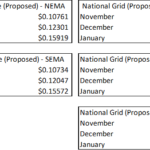
The U.S natural gas markets have been constrained by increases in LNG exports, reduced gas production and storage, and returns to pre-covid levels of demand. Natural Gas prices have risen from the $3 level to $5, and in the New England area natural gas prices are big determinants of electricity prices. Given this recent constraint….








